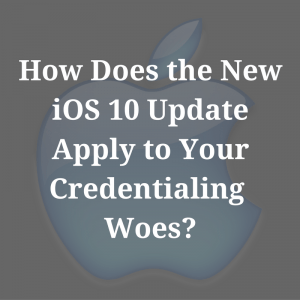 Apple iOS 10 Update
Apple iOS 10 Update
The Twitter universe has been a flutter with news about the new Apple iOS 10 update. Unfortunately, the news wasn’t all that great. Not surprisingly, the biggest complaint was the new emojis featured by Apple. The biggest change: the emoji of a pistol to a water gun and all emojis now feature skin tones so you may choose the color of your emoji’s skin. The best comment I saw was, “Dear Apple, changing the gun to a water gun and adding skin tones won’t stop gun violence or racism.” It’s kind of like saying if you give your failing employee a new computer she will suddenly be a shining star for your organization. That is simply a wolf in sheep’s clothing. You’ve masked the real problem. Let’s talk about how to make changes to your credentialing software (the real problem) that are well thought out and lead to you trending on Twitter for all the right reasons (unlike Apple).
The Importance of Technology in Credentialing
In Healthcare, everything is connected. From the phone operator to the check out desk to the insurance collector, every single piece plays a part in the puzzle that is healthcare. If any piece of the puzzle is no longer performing at optimal capacity, another piece of the puzzle will suffer. It all starts with credentialing. If your provider is not credentialed, there can be no other puzzle pieces. The puzzle is simply lacking the piece it needs to move forward. If you do not have a solid process in place to perform credentialing of your healthcare providers, you are missing out on revenue and a chance to be quick and efficient. Technology plays a key role in credentialing. Harnessing the power of technology is your best bet to ensure your providers initially get credentialed and stay credentialed so your claims pay cleanly, every time.
Selecting a Credentialing Technology
Many technologies can be used to keep track of your credentialing to ensure nothing is missed. When evaluating a new technology or software for credentialing, you must always ensure that the company actually owns the software. Many companies are simply leasing their software from the developer. These developers don’t actually know how to credential a provider and therefore, their systems are often sub-par. Ensuring that the system you use is actually owned by the company you are leasing it from solidifies they know credentialing inside and out; how else could they develop and create a credentialing system?
Next, when deciding on a software, be sure that the company who sells or will lease the software to you is actually a credentialing company who offers credentialing services. There is no better testimony of the value of a software than knowing that an actual credentialing company uses the software in their day-to-day business and is successful doing so. Also, ask for client references. Be sure to call all references and verify how they use the system and what complaints they have about the system. Knowing what clients complain about gives you questions to ask of the software developer and also gives you expectations of what the system can and cannot do for you and your company.
Credentialing is the #1 Priority
Whatever you decide, be sure that credentialing is always your number one priority. Whether you are a billing company, Practice Manager, or Practice Consultant, the healthcare revenue cycle starts with credentialing. Find a service provider that allows your company to perform credentialing on your terms and within the scope of your company’s policies and procedures.
For more helpful tips and tools please:
- Follow us on LinkedIn.
- Like us on Facebook.
- Follow us on Twitter.
- Follow us on Google+.
- Sign up for our newsletter.
Cynthia Young, the former CEO of STAT, which is a U.S.-based, national provider of credentialing, payor enrollment, rate negotiation, and other credentialing related services.





